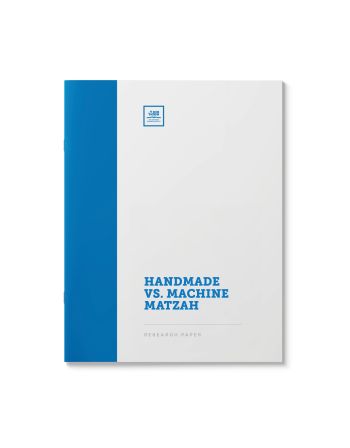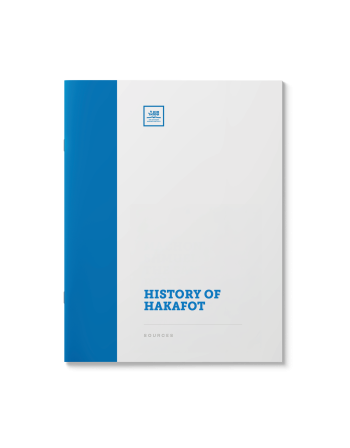- Faith and Religion - עניני דת ואמונת ה׳
- Law and Justice - משפט צדק
- Torah and Science - תורה ומדע
- The Holy Temple - עניני בית המקדש
- Miscellaneous - שונות
- Current Events - עניני השעה
- Moshiach and Redemption - משיח וגאולה
- Ethics and Morality - מילי דחסידותא
- Jewish Identity - זהות היהודית
- The Nations of the World - בין ישראל לעמים
- Prayers and Blessings - עניני תפלה וברכות
- Synagogue and Rabbinic Matters - עניני בית הכנסת ורבנות
- Shabbat and Jewish Holidays - עניני שבת וימים טובים
- Contemporary Matters - נושאים עכשויים
- Family Matters - משפחה היהודית
- Women and Feminism - מעמד האשה ביהדות
- Money Matters - משא ומתן
- Lifecycle Events - מעגל החיים
- Language and Literature - עיונים בשבילי התורה
- Biblical Events and Figures - מאורעות ואישי התנ״ך
- Kabbalah and Jewish Mysticism - קבלה ותורת הסוד
- Jewish Practice and Traditions - מסורת ומצוות תמידיות
-
Friday Lights $39.00
Shabbat candles are perhaps one of the most evocative images of Jewish life. What is the source for this practice? Where, and how many, Shabbat candles are lit?
-
Gefilte Fish $39.00
In response to the buzz surrounding #GefilteFishGate, we shared the following material (free) on our social media feed on Facebook and Twitter
This is where we stand on #GefilteFish
Follow us there for more exclusive content! -
Gender Modification and Jewish Law (Sources) [New!] $75.00
“Man and woman He created them” (Bereishis 1:27).
Newborn babies arrive from the mint of the Creator assigned with a particular gender. But does this have to remain this way? What if people feel that they ought to belong to the opposite gender? What is the Torah perspective regarding availing oneself of modern techniques to align one’s physical features with one’s “gender identity”?
Throughout history there have been medical anomalies which have not fit neatly into the standard definitions of male or female. This collection also documents some of those instances as addressed by the Torah authorities of their times.Related: Alternative Lifestyles
-
Get by Force $39.00
What is the position of contemporary halachic authorities regarding
coercing a husband to provide a Get for his wife? – reviewed here in light of
the recent scandal. -
Gladness and High Spirits: A Review of Oneg Shabbos $39.00
This paper features a curricular overview of the mitzvah of experiencing Oneg Shabbos.
-
Gone Without a Trace – Mourning an Unverified Death $39.00
Missing persons raise
tough questions. How long must we wait before they are presumed dead? What is
the mourning process? And may the missing person’s spouse ever remarry? -
Great Shakes: Understanding the Mitzvah of Shaking the Lulav and Esrog $75.00
Up, down, left, right, the lulav nanuim are a bewildering sight. This paper delves into the mysticism behind the historically venerated mitzvah of shaking lulav and esrog. What are its origins? What does it represent? How is it relevant today?
-
Hagar 101 $39.00
If Avraham was specifically
instructed to refrain from marrying a maidservant, how was he permitted to
marry Hagar? How could Avraham marry Hagar if Jews may not marry a first or second-generation
Egyptian convert? Was Hagar betrothed through a form of kiddushin or was
she considered a concubine? Was the marriage of Avraham and Hagar divinely
ordained? -
HaMan: The Villain and the Miracle Food $39.00
Given that both Haman and ‘the Manna’ are spelled the same,
is there any deeper connection between the two?
Legend of a Cookie – The Purim cookie. Three corners, folded to swathe a filling. Supposedly it is named after the wicked Haman from the Purim story. How is this cookie reminiscent of the wicked Haman? (Sources) -
Handmade vs. Machine Matzah $39.00
What’s the difference between the two types? Why do some people prefer one over the other? And why is the Chabad preference for hand-made matzah?
-
Healing in the Hereafter $39.00
Without question, our prize possessions are the children we raise, and it is they who remain our legacy after we depart from the world.
Traditionally, children pledge funds to tzedakah and perform other good deeds in the merit of their deceased parents and loved ones.
What are the legal and philosophical arguments in defense of the idea that the deceased may enjoy the merits accrued by the good deeds of others? What if the individual was less-than righteous? Can the tzedakah by community members benefit their soul as well? What makes Yom Kippur a most propitious day to pledge tzedakah for the deceased? -
Hezek Re’iah: If Looks Could Kill… $39.00
A
review of the laws of hezek re’iah, visual trespass: the
liability, the breach, and the damages. -
His Name Was Moshe $39.00
Moshe’s name is perhaps the most recognized name in all of Judaism, the name of arguably the greatest Jewish leader of all time – and a name that was given to him by an Egyptian Princess. Why did the Torah choose his Egyptian name as the name to be remembered for posterity? Why wasn’t his Jewish name recorded? And what was his Jewish name?
-
History of Hakafot (Sources) $39.00
One of our most festive Holidays, an all-out celebration of the Torah, has neither Scriptural nor Talmudic basis.
These sources trace the development of this custom as well as many others related to Simchas Torah:
The yearly schedule for completing the reading of the Torah, the ensuing celebration and unique liturgy read on this occasion, the custom of dancing and circling the Bima seven times, other celebratory expressions such as marching with candles, torches and much more.
Also includes a collection of anecdotes regarding the importance of experiencing joy during this event.
(Hebrew) -
Holding the Torah While Upholding Halachah $39.00
The prevailing custom is that those who are ritually impure, such as a niddah, do not place themselves in contact with a Sefer Torah. This paper traces the origins of this practice and addresses its practical implications, such as entering a shul, kissing the Torah and dancing with it during hakafot.
-
Honor is not Dead: Kibud Av V’Em $39.00
Many of contemporary society’s challenges could be remedied by the observance of the mitzvah of honoring one’s parents. Yet Kibbud Av V’Em is a broad and sweeping mitzvah with vaguely defined boundaries. To what extent are we obligated? Are we required to sacrifice our own social life to care for our parents? Does it apply to marriage partners? How do we define respect? Learn the Torah’s definition of honoring our parents.




![Gender Modification and Jewish Law (Sources) [New!]](https://catalog.myjli.com/wp-content/uploads/2025/05/SAMSGMJL-350x448.png)












